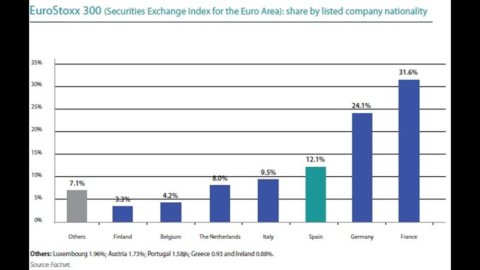“The imbalances persist, but they have all been diagnosed. It is necessary to accelerate the process of reforms and rigorously carry out those already set in motion." This can be read in the July report of the Spanish Business Council for Competitiveness (CEC). The Council, made up of 17 major companies in the Iberian Peninsula (including Telefonica, Repsol, Iberdrola, El Corte Inglés), was born at the beginning of the year with the aim of combating the high-risk image associated with the Spanish economy . Image that contrasts with the position of world leader held by some multinationals in strategic sectors such as construction, banking or renewable energy. However, we must not forget that there are also small companies and that lately they have not been doing too well (see the article by Michael Calcaterra on Firstonline).
Competitive large companies – The Cec document states that Spanish companies have a weight of 12,2% in the Eurostoxx 300 European index, in third position after France and Germany (see photo). Companies like Telefonica, Iberdola and Repsol and banks like Santander and BBVA are in the top 10 of their respective sectors in terms of capitalization. For the first time in history, 12 of the 38 industries on the Forbes list are Spanish. The high productivity of large companies (more than 250 employees), which exceeds that of German companies of the same size by 10% and those of England by 20%, is what makes them among the most profitable in the world.
Crisis effects 2007/2010 – Over the past 50 years, the history of Spain has marked a social and economic success comparable to the progress of Japan and post-war Germany. Between 1960 and 2010, Spain tripled its weight in the Europe of 15 (see photo). However, the deep crisis has revealed a series of imbalances in its economy such as high private sector debt, a high current deficit, an overvaluation of real estate assets and a great inflexibility of the labor market.
But Spain is working on it and the big 17, coordinated by President Fernando Casado, recognize the Government's commitment to reduce the deficit and underline the importance of a further effort in public administrations, especially in the regions, where in 2010 debt was reached 11% of GDP.
High debt of the regions – Spain has many cities and small towns (about 8000) and one of the lowest populations per city. 60% of the villages have a population of less than 1000 inhabitants, and almost half of these have fewer than 500. This leads to a high cost per inhabitant in the remuneration of public offices, about 5 times the European average. The document reads the proposal to reduce the costs of the autonomous communities with a lightening of the territorial administration or through a rationalization of fiscal federalism, with greater transparency and controls.
Deficit and public debt – But the ghost of the debt crisis continues to hover over Spain. The WCC points out that the debt/GDP rate, although it increased during the crisis, continues to remain among the lowest in OECD countries (see photo).
Thanks to the surpluses accumulated between 2004 and 2006, the Iberian Peninsula has been less affected by the last crisis (2007-2010). According to estimates by the International Monetary Fund, the budget deficit will converge towards the main rates in central Europe and in 2013 the debt, in terms of percentage of GDP, will be at the levels of Germany and far from the values of the other Mediterranean countries. The European Commission is also confident and in its data it predicts that Spain will continue to devolve about 7% of public revenues to pay interest on its debt, a percentage similar to that of France and Germany. However, what weighs the most on Spanish debt is the high portion in the hands of international investors (about 50%), which makes it more exposed to market speculation.
However, the austerity plan implemented by the Government (which provides for a reform of the banking system and the labor market) will allow it to achieve the objectives of the Stability Pact within the next two years. In 2010 the mission was accomplished and according to the Cec the Spanish economy will return to growth in 2013 at rates similar to the pre-crisis ones. Rating agencies permitting.




